Can you imagine the feeling of hitting the trail, your feet snugly encased in sturdy hiking boots, as you break into a run?
In this article, we will delve into the possibilities of running in hiking boots. Discover the benefits, factors to consider, and tips for a successful run.
However, it’s important to be aware of the potential risks involved.
If you’re curious about alternatives to running in hiking boots, we’ve got you covered.
Let’s lace up and explore the exciting world of running in hiking boots!
Table of Contents

Related Video: "Are Trail Running Shoes Good For Hiking? | HikingBeginner.com" by HikingBeginner
Main Points
– Running in hiking boots offers enhanced performance on rugged terrains and excellent ankle support.
– It is important to evaluate the condition, weight, flexibility, and fit of the boots before running in them.
– Tips for running in hiking boots include breaking them in, choosing boots with flexible soles and good traction, lacing them snugly, and wearing moisture-wicking socks.
– Potential risks of running in hiking boots include lack of flexibility, increased weight and strain on muscles and joints, inadequate cushioning and shock absorption, and potential discomfort, blisters, and foot injuries.
Benefits of Running in Hiking Boots
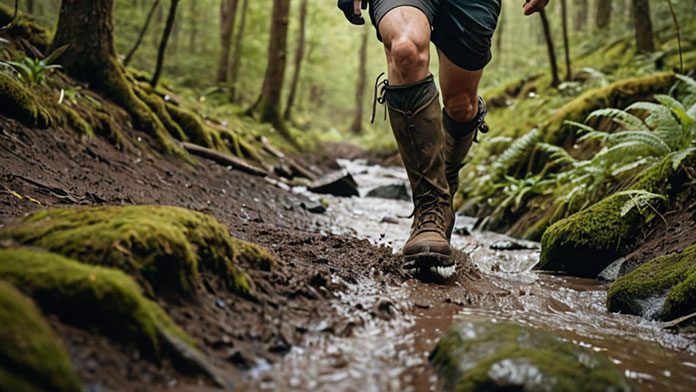
When running in hiking boots, you can experience several benefits for your overall fitness and endurance. Contrary to popular belief, running in hiking boots isn’t only possible but can also be advantageous in certain situations.
Hiking boots are designed to provide stability, support, and protection on rugged terrains, which can translate into enhanced performance during running activities.
Firstly, hiking boots offer excellent ankle support, reducing the risk of sprains and twists. The high-top design and sturdy construction of these boots provide a secure fit, minimizing the chances of ankle injuries while running on uneven surfaces. Additionally, the thick soles of hiking boots provide superior cushioning and shock absorption, reducing the impact on your joints and muscles.
Moreover, the durable materials used in hiking boots make them suitable for various terrains, including trails and off-road conditions. Their rugged outsoles offer excellent traction, ensuring a firm grip even on slippery or muddy surfaces. This added stability can enhance your running technique and prevent potential slips or falls, allowing you to maintain a steady pace and focus on your stride.
Lastly, running in hiking boots can also be an effective way to strengthen your leg muscles. The added weight and resistance provided by the boots can help build endurance and improve overall lower body strength. This can be particularly beneficial for trail runners or those training for long-distance races.
Factors to Consider Before Running in Hiking Boots
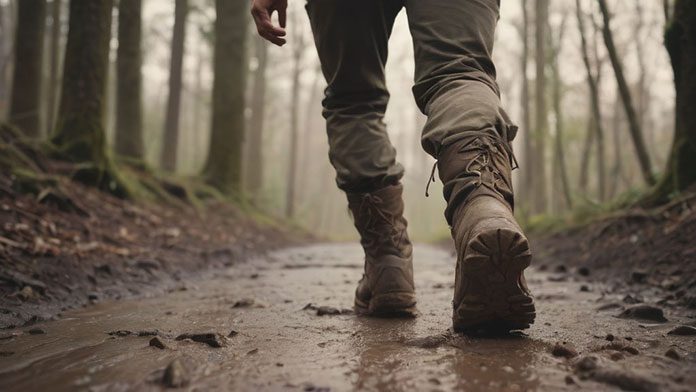
Before running in hiking boots, there are several factors you should consider.
Firstly, it’s essential to evaluate the condition of your boots. Running in worn-out or damaged hiking boots can lead to discomfort, blisters, and even injuries. Make sure the soles are still in good shape and provide adequate traction.
Additionally, consider the weight and flexibility of your boots. Running requires lightweight and flexible footwear to allow for natural foot movement and reduce strain on your muscles and joints. Hiking boots, on the other hand, are designed for stability and support on uneven terrain, which can make them heavier and less flexible compared to running shoes.
Another crucial factor to consider is the fit of your hiking boots. Running puts different demands on your feet compared to hiking, so it’s important to ensure that your boots fit properly and provide enough room for toe splay and foot swelling during exercise.
Finally, keep in mind that running in hiking boots may affect your running form and efficiency. The sturdy construction of hiking boots can alter your biomechanics, potentially leading to discomfort or injury. It’s advisable to gradually transition to running in hiking boots and pay attention to any changes in your gait or discomfort during your runs.
Tips for Running in Hiking Boots
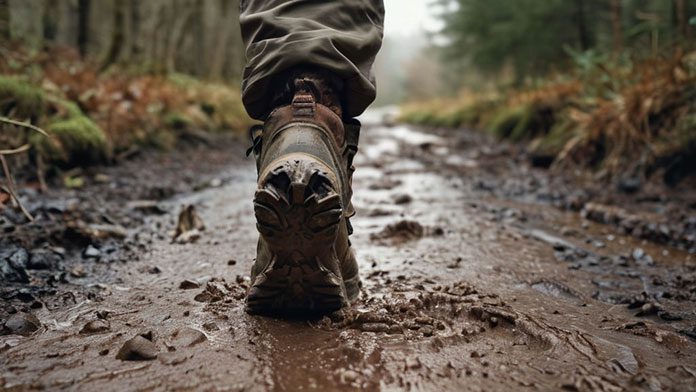
To enhance your running experience in hiking boots, consider these practical tips.
First and foremost, make sure your hiking boots are properly broken in before attempting to run in them. This will help prevent blisters and discomfort during your run.
Additionally, choose hiking boots that have a flexible sole and good traction. A flexible sole will allow for natural foot movement while running, and good traction will provide stability and prevent slipping on uneven terrain.
When lacing your hiking boots for running, use a technique that provides a snug fit without being too tight. This will help prevent your feet from sliding around inside the boots, reducing the risk of blisters and improving overall control and stability.
It’s also important to wear moisture-wicking socks to keep your feet dry and prevent blisters.
During your run, pay attention to your form and stride. Hiking boots have a stiffer structure compared to running shoes, so it’s important to maintain good posture and avoid overstriding. Shorter, quicker strides will help you maintain balance and reduce the risk of twisting an ankle.
Lastly, after your run, take the time to clean and properly care for your hiking boots. This will help maintain their durability and performance over time.
Following these tips will ensure a more enjoyable and comfortable running experience in your hiking boots.
Potential Risks of Running in Hiking Boots
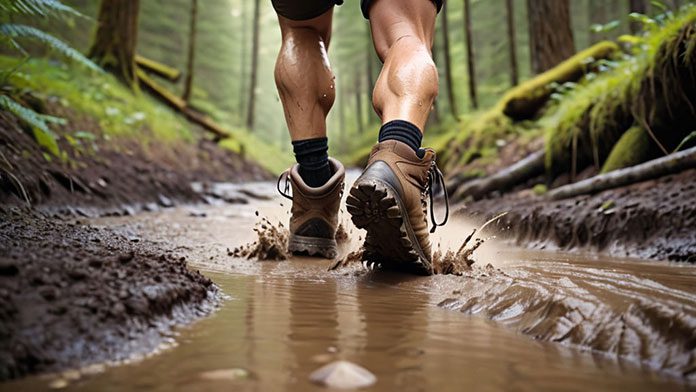
Running in hiking boots comes with potential risks that you should be aware of. While hiking boots are designed to provide support and stability on uneven terrain, they may not be the best choice for running.
One of the main risks is the lack of flexibility in hiking boots. Unlike running shoes, which are designed to allow for natural movement of the feet, hiking boots are stiffer and less flexible. This can lead to discomfort, blisters, and even foot injuries.
Another risk is the increased weight of hiking boots compared to running shoes. The added weight can put extra strain on your muscles and joints, increasing the risk of fatigue and overuse injuries. Additionally, hiking boots may not provide adequate cushioning and shock absorption, which can further increase the risk of impact-related injuries.
Finally, the traction of hiking boots may not be suitable for running on pavement or other hard surfaces. The deep lugs and aggressive tread pattern can make it difficult to maintain proper running form and increase the risk of slipping or tripping.
Alternatives to Running in Hiking Boots
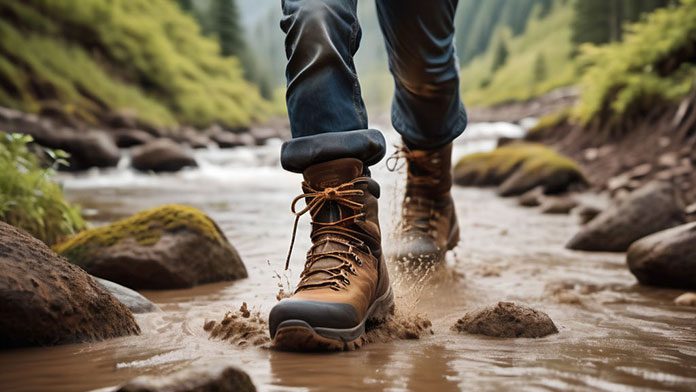
If you rarely run and prefer a more comfortable option, consider wearing lightweight running shoes instead of hiking boots. Running in hiking boots can be cumbersome and may increase the risk of injuries. Here are three alternatives to running in hiking boots that you should consider:
1. Lightweight Running Shoes: Opting for lightweight running shoes can provide you with the necessary support and cushioning while allowing for better flexibility and agility. These shoes are specifically designed for running, with features such as breathable mesh uppers and responsive midsoles that absorb shock and provide energy return.
2. Trail Running Shoes: If you still want the durability and traction of hiking boots but with a lighter feel, trail running shoes are an excellent alternative. They offer a more streamlined design and are specifically engineered for off-road running. These shoes typically have aggressive lugs on the outsole to provide superior traction on uneven terrain.
- Minimalist Shoes: For experienced runners who prefer a more natural feel, minimalist shoes can be a great option. These shoes have a minimal drop from heel to toe and a lightweight design that allows for a more natural foot movement. However, it’s important to note that transitioning to minimalist shoes requires a gradual adaptation period to avoid potential injuries.
Frequently Asked Questions
Can You Use Hiking Boots for Trail Running?
Yes, you can use hiking boots for trail running. They provide stability, protection, and grip on rugged terrain. However, they may lack the cushioning and flexibility of running shoes, impacting comfort and speed.
Are Hiking Boots Suitable for Long-Distance Running?
Yes, hiking boots can be suitable for long-distance running. They provide ankle support and traction, reducing the risk of injury on uneven terrain. However, they are heavier and less flexible than running shoes, impacting speed and agility.
What Type of Terrain Is Best for Running in Hiking Boots?
The best type of terrain for running in hiking boots is rugged and uneven. These boots offer excellent traction and stability, making them ideal for trails with loose rocks, mud, or steep inclines.
Can Running in Hiking Boots Improve Ankle Stability?
Running in hiking boots can improve ankle stability by providing more support and protection. The sturdy construction and high ankle design help prevent ankle sprains and twists, allowing you to confidently navigate various terrains.


